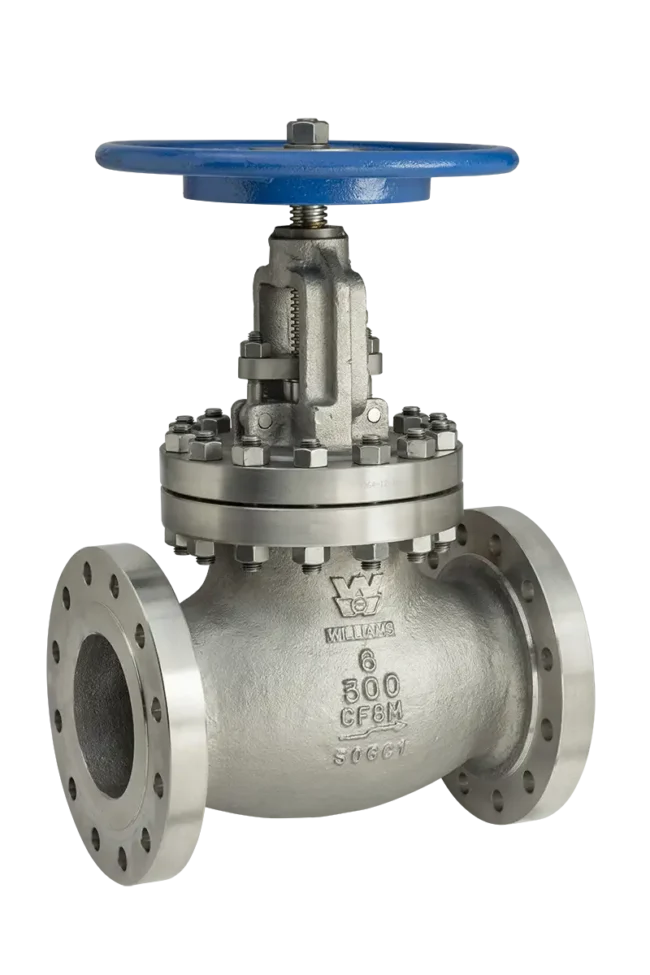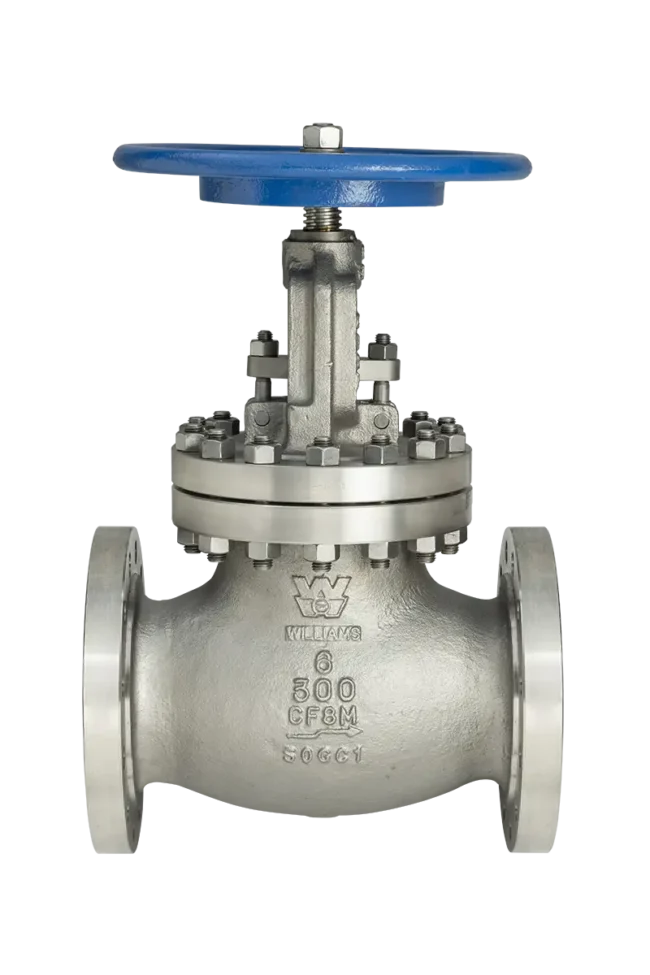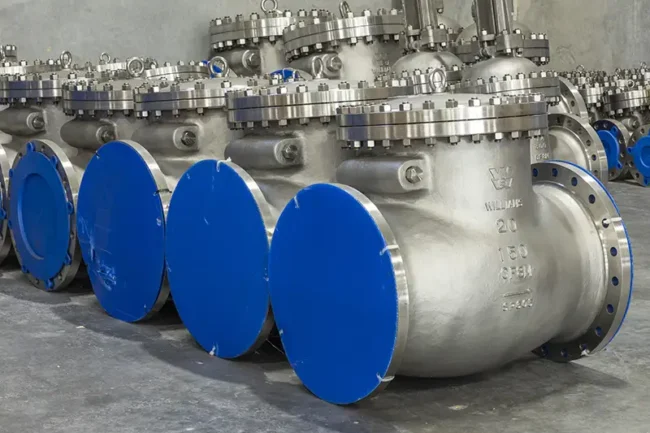Globe Valves for Industrial and Commercial Applications
 Globe valves are a distinct type of linear motion valve used for regulating or throttling fluid flow, as well as for stopping and starting flow. They excel at modulating flow rates.
Globe valves are a distinct type of linear motion valve used for regulating or throttling fluid flow, as well as for stopping and starting flow. They excel at modulating flow rates.
Partner with Williams Valve for all of your industrial and commercial valve needs. Our quality products, customized solutions, and dedicated service work together to support your operational efficiency and reduce costly downtime.
Primary Applications for Globe Valves
Globe valves are invaluable in industrial systems where precise flow control is required, including:
- Process Control: Function as control valves in many industrial processes, where their throttling capability allows for automatic regulation of flow, pressure, and temperature when coupled with an actuator and control system.
- High-Pressure, High-Temperature Services: Their solid construction and tight sealing make them suitable for demanding environments.
- Steam Systems: Widely used in power plants and industrial facilities for controlling steam flow, blowdown lines, and drain lines due to their ability to handle high temperatures, pressures, and the erosive nature of steam.
- Boiler Feedwater Systems: Manage the precise amount of water fed into boilers to maintain efficiency and safety.
- Cooling Water Systems: Control the flow of cooling water to various equipment.
- Fuel Oil Systems: Used in fuel lines to control the flow of fuel oil to burners or engines.
- Chemical Processing: Regulate the flow of various chemicals, especially where precise dosing or mixing is required.
- Sampling Lines: Often used in sampling lines where small, precise flows are needed.
Cast Steel Drawings
Forged Steel Drawings
Stainless Steel Drawings
Is a Globe Valve Right for Your Operation?
 When managing fluid flow, globe valves are often a go-to option. However, they’re not a universal solution. This guide will help you determine if a gate valve is the optimal choice for your particular operational requirements.
When managing fluid flow, globe valves are often a go-to option. However, they’re not a universal solution. This guide will help you determine if a gate valve is the optimal choice for your particular operational requirements.
- Excellent Throttling Capability: Their primary advantage, allowing for precise regulation of flow rates.
- Good Shut-off Capability: Provide a tight seal when fully closed, minimizing leakage.
- Less Susceptible to Seat Wear in Throttling: Unlike gate valves, the design of a globe valve protects the seat from erosion when used in a partially open position, which means they should have a longer service life.
- Shorter Stem Travel: Compared to gate valves, globe valves generally have a shorter stroke to achieve full open or closed, which can lead to faster actuation times with certain actuators.
- Easy Maintenance: Discs and seats can often be refurbished or replaced relatively easily.
- High Pressure Drop: The inherent design causes significant flow resistance and pressure drop across the valve, leading to increased energy consumption.
- Higher Cost: Generally more expensive than gate valves of comparable size and rating.
- Larger Size and Weight: Can be bulkier and heavier than other valve types for similar flow capacities.
- Limited for Slurries or Viscous Fluids: The tortuous flow path and potential for material accumulation around the disc and seat can make them unsuitable for fluids with high solid content or viscosity, leading to clogging or erosion.
- Unidirectional Flow (often): While some designs allow bidirectional flow, many globe valves are designed for flow in a specific direction to prevent disc chatter or excessive force on the stem.
Our Globe Valve Designs and Materials
 Globe valves have a superior ability to regulate flow thanks to their design that incorporates a movable disc that moves perpendicularly to a stationary ring seat. As the disc is raised or lowered, it progressively changes the size of the opening through which the fluid flows, allowing for precise control of the flow rate. When the disc is seated firmly against the ring seat, it creates a tight shut-off and minimizes leakage when fully closed.
Globe valves have a superior ability to regulate flow thanks to their design that incorporates a movable disc that moves perpendicularly to a stationary ring seat. As the disc is raised or lowered, it progressively changes the size of the opening through which the fluid flows, allowing for precise control of the flow rate. When the disc is seated firmly against the ring seat, it creates a tight shut-off and minimizes leakage when fully closed.
These valves feature a non-straight flow path, often with two or more changes in direction. This tortuous path is what creates the high pressure drop across a globe valve. This energy loss is generally considered a trade-off for its excellent throttling capability.
Similar to gate valves, globe valves have relatively slow operation as they require multiple turns of the handwheel or actuator to open or close. However, this can help prevent water hammer during closing.
Depending on the type of globe valve chosen, your globe valve design may incorporate:
- Full Port or Standard Port
- Outside Screw and Yoke (OS&Y)
- Two Piece Self-Aligning Packing Gland
- Bolted Bonnet with Spiral-Wound Gasket, Threaded and Seal Welded Bonnet, or Threaded and Pressure Seal Bonnet
- Integral Backseat
- Loose Solid Disc
- Grease Nipple for Stem
- Socket Weld Ends or Screwed Ends (NPT)
Forged Steel Globe Valves
Globe valves are available in three bonnet designs:
Bolted Bonnet
- Male-female joint
- Spiral wound gasket
- Made of F304L/graphite
- Ring joint gasket available on request
Welded Bonnet
- Threaded and seal welded joint
- Full penetration welded joint available on request
Pressure Seal Bonnet
- Threaded and pressure seal bonnet joint
Forged Steel Bellows Seal Valves
Bellows seal valves are available in two bonnet designs:
Bolted Bonnet
- Male-female joint
- Spiral wound gasket
- Made of F304L/graphite
- Ring joint gasket available on request
Welded Bonnet
- Threaded and seal welded joint
- Full penetration welded joint available
Body Materials
Globe valves can be manufactured from different materials to match your fluid, temperature, and pressure conditions.
- Carbon Steel: Common for higher pressures and temperatures in general industrial applications.
- Stainless Steel (304, 316): For corrosive fluids, food and beverage, pharmaceutical, and hygienic applications.
- Alloy Steels: For extremely high temperatures, pressures, or highly corrosive environments.
- Bronze: For valves in water or commercial marine systems, and for low-pressure steam.
Design and Manufacturing Compliance
Our globe valves conform to:
- API 602 – Gate, Globe, and Check Valves for Sizes DN 100 (NPS 4) and Smaller
- BS 5352 – Steel Wedge Gate, Globe and Check Valves of Nominal Sizes 50 and Smaller
- ASME B 16.34 – Valves—Flanged, Threaded, and Welding End
- API 598 – Valve Inspection and Testing
- MSS SP-25 – Standard Marking System for Valves, Fittings, Flanges, and Unions
- MSS-SP-118 – Compact Steel Globe & Check Valves – Flanged, Flangeless, Threaded & Welding Ends
- ASME B16.34 – Valves – Flanged, Threaded, and Welding End
- ASME B16.11 – Forged Fittings, Socket-Welding and Threaded (for Socket Weld Ends)
- ASME B1.20.1 9 – Pipe Threads, General Purpose (for Screwed Ends)
Types of Globe Valves Available

- Cast Steel Bolted Bonnet Angle Valves 150lb – 300lb
- Cast Steel Bolted Bonnet Globe Valves 150lb – 2500lb
- Forged Steel Cryogenic Globe Valves 800lb & 1500lb
- Forged Steel Y Globe Valves 800lb & 1500lb
- Forged Steel Globe Valves 800lb & 1500lb
- Forged Steel Flanged Bolted Bonnet Globe Valves 150lb, 300lb, & 600lb
- Stainless Steel Flanged Cryogenic Globe Valves 150lb, 300lb, & 600lb
- Stainless Steel Globe Valves 200lb WOG
- Bronze Marine Flanged Hose End Globe & Angle Valves 150lb
- Bronze Marine Flanged Angle Valves 150lb
- Bronze Marine Flanged Globe Valves 150lb
- Bolted Bonnet T-Pat & Y-Pat Globe
- Corrosion Resistant Bolted Bonnet Globe
- Pressure Seal Bonnet T-Pat & Y-Pat Globe
- Forged Steel Bolted Bonnet Globe
- Forged Steel Welded Bonnet Globe
- Cryogenic Cast Steel Bolted Bonnet Globe
- Cryogenic Cast Steel Bolted Bonnet Globe
- Cast Steel Marine T-Pat & Angle Globe – ABS Type Approved
- Bronze Marine T-Pat & Angle Globe – ABS Type Approved
- Mil-Spec T-Pat & Angle Globe
Globe Types – Quick Overview
- T-Pattern Globe Valve: The most common design, where the stem and disc move perpendicular to the flow direction. Has the highest pressure drop but excellent throttling.
- Angle Pattern Globe Valve: A modification where the inlet and outlet are at a 90-degree angle, allowing for a single 90-degree turn in the fluid path. This reduces pressure drop compared to the T-pattern and is good for pulsating flows.
- Y-Pattern Globe Valve: Features a body where the stem and seat are angled at approximately 45 degrees to the main flow path. This provides a straighter flow path and significantly reduces pressure drop. This design is often preferred for applications where throttling is needed but pressure drop must be minimized, or for high-pressure/high-temperature services.
- Ball Disc Globe Valve: Used for lower pressure and temperature applications. Best for on/off service but has some throttling capability.
- Composition Disc Globe Valve: Uses a non-metallic insert ring on the disc for tighter closure, often found in steam and water systems.
- Plug Disc Globe Valve: Features a long tapered plug, offering the best throttling characteristics among disc types and high resistance to erosion.
Supplier and Service Provider for Industrial Globe Valves
For precision flow control, get the industrial valve solution you need from Williams Valve. We manufacture and modify a full range of high-quality industrial globe valves. All of our products are engineered for durability and optimal performance in critical applications. Get a free quote for industrial valves today.
